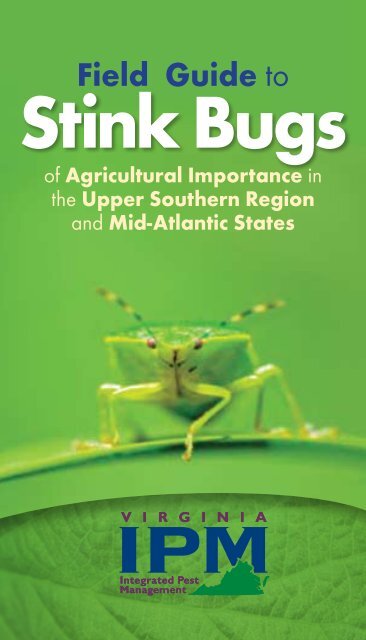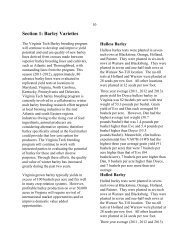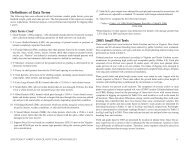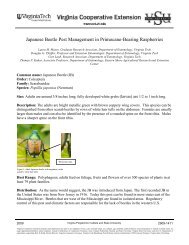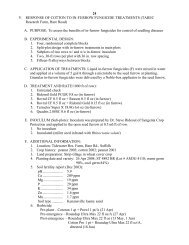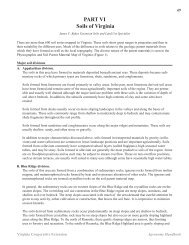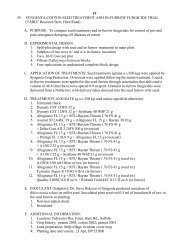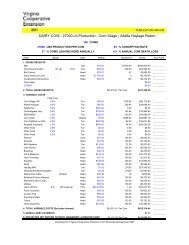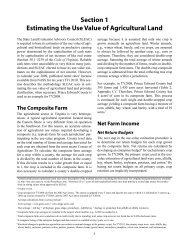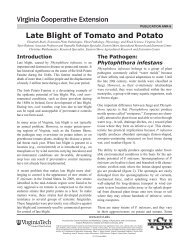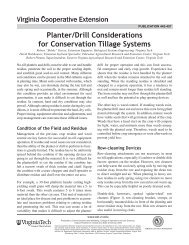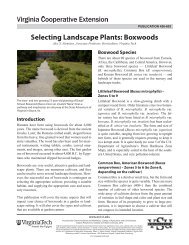Field Guide to Stink Bugs - Virginia Tech
Field Guide to Stink Bugs - Virginia Tech
Field Guide to Stink Bugs - Virginia Tech
Create successful ePaper yourself
Turn your PDF publications into a flip-book with our unique Google optimized e-Paper software.
<strong>Field</strong> <strong>Guide</strong> <strong>to</strong><br />
<strong>Stink</strong> <strong>Bugs</strong><br />
of Agricultural Importance in<br />
the Upper Southern Region<br />
and Mid-Atlantic States
i<br />
<strong>Field</strong> <strong>Guide</strong> <strong>to</strong> <strong>Stink</strong> <strong>Bugs</strong> of<br />
Agricultural Importance in the Upper<br />
Southern Region and Mid-Atlantic States<br />
Authors:<br />
Katherine Kamminga, <strong>Virginia</strong> <strong>Tech</strong><br />
D. Ames Herbert, Jr., Extension En<strong>to</strong>mologist, <strong>Virginia</strong> <strong>Tech</strong><br />
Sean Malone, Research Specialist, <strong>Virginia</strong> <strong>Tech</strong><br />
Thomas P. Kuhar, En<strong>to</strong>mologist, <strong>Virginia</strong> <strong>Tech</strong><br />
Jeremy Greene, En<strong>to</strong>mologist, Clemson University<br />
Produced by:<br />
Communications and Marketing, College of<br />
Agriculture and Life Sciences, <strong>Virginia</strong> <strong>Tech</strong><br />
Tim FisherPoff, Graphic Designer<br />
Linda Burcham, Publications Coordina<strong>to</strong>r
Pho<strong>to</strong> Credits<br />
Ralph Bagwell, Bayer CropScience .......................................... 39, 89<br />
Bob Barber ............................................................................................61<br />
Thomas Bentley ........................................................................... 45, 53<br />
Mark Brown, USDA, ARS ............................................................ 78, 79<br />
Margarethe Brummermann ............................................................. 60<br />
C. Scott Bundy, New Mexico State University ......27, 28, 30, 36, 51<br />
Patrick Coin ...................................29, 47, 49, 50, 54, 56, 57, 62, 96<br />
Stephen Cresswell .............................................................................. 59<br />
Tim FisherPoff ..............................................................Figures 1, 2, 3, 4<br />
Jim Gilbert ..............................................................................Front Cover<br />
Jeremy Greene, Clemson University .......... 8, 10, 31, 32, 63, 84, 87<br />
Joyce Gross .......................................................................................... 52<br />
Henry Hogmire, West <strong>Virginia</strong> University ........................... 75, 76, 77<br />
Katherine Kamminga, <strong>Virginia</strong> <strong>Tech</strong> ...........................3, 4, 5, 12, 13,<br />
14, 17, 18, 64, 65, 66, 80, 81, 85, 90, 91, 92, 93, 94, Back Cover<br />
Thomas Kuhar, <strong>Virginia</strong> <strong>Tech</strong> .........................................40, 41, 42, 70<br />
David R. Lance, USDA, APHIS PPQ, www.insectimages.org ...... 26, 97<br />
Deepak Matadha ................................................................. 23, 24, 25<br />
Ron Melder ......................................................................43, 44, 55, 58<br />
Russ Ottens ..............................................................................37, 38, 88<br />
David Owens, <strong>Virginia</strong> <strong>Tech</strong> ................................................1, 2, 48, 74<br />
Herb Pilcher, USDA, ARS, Bugwood.org ...............................................<br />
................................. 6, 11, 15, 16, 19, 20, 21, 22, 33, 34, 35, 86, 95<br />
Robert Pitman, <strong>Virginia</strong> <strong>Tech</strong> .............................................................. 83<br />
Phillip Roberts, University of Georgia ..................................67, 68, 69<br />
Scott Stewart, University of Tennessee ...............................7, 9, 46, 82<br />
John Van Duyn, North Carolina State University .............. 71, 72, 73
iii <strong>Stink</strong> Bug Diagram<br />
Thorax<br />
Antennae<br />
Head<br />
Abdomen<br />
Wings Figure 1
Margins<br />
“Shoulders”<br />
Scutellum<br />
Figure 2<br />
Jugum<br />
Tylus<br />
Tarsi<br />
1<br />
Pronotum<br />
2<br />
3<br />
iv
1<br />
1<br />
3<br />
4<br />
Economically Important Species<br />
Green stink bug, Acrosternum hilare (Say)<br />
Hatched<br />
2<br />
Unhatched<br />
ADULT SIZE<br />
Eggs: One of the largest stink bug<br />
eggs and deposited in clusters of<br />
approximately 20-50. Micropylar<br />
processes (little nubs at the crown<br />
of the egg) are numerous and bend<br />
distinctly at the end; distinctively<br />
pure white until ready <strong>to</strong> hatch;<br />
egg shell is smooth.<br />
Nymphs: Early instars are mostly<br />
black with orange markings. Later<br />
instars with a mostly black<br />
or green head and thorax;<br />
abdomen mostly green<br />
with dark spots down<br />
the center. Darker color<br />
forms are common.<br />
Adults: Green with<br />
black bands on antennae;<br />
pointed spine on the<br />
underside of the abdomen<br />
between where the hind<br />
legs attach <strong>to</strong> the body.<br />
5
6<br />
Southern green stink bug, Nezara viridula (L.)<br />
7<br />
8<br />
Economically Important Species 2<br />
ADULT SIZE<br />
Eggs: White changing <strong>to</strong> pink<br />
as they mature; deposited in<br />
hexagon-shaped clusters of rows<br />
with approximately 150 eggs<br />
per cluster.<br />
Nymphs: Early instars are<br />
dark brown. Later instars<br />
are green with white spots on<br />
the abdomen with pink-red<br />
markings around the outer<br />
edge.<br />
Adults: Green with red bands<br />
on antennae; rounded spine on<br />
the underside of the abdomen<br />
between where the hind legs<br />
attach <strong>to</strong> the body.<br />
9<br />
10
3<br />
11<br />
Economically Important Species<br />
Brown stink bug, Euschistus servus (Say)<br />
14<br />
12<br />
ADULT SIZE<br />
Eggs: Manila-colored (less<br />
white than green stink bug<br />
eggs) and deposited in looselybound<br />
clusters; rough-looking<br />
egg shell.<br />
Nymphs: Head and<br />
pronotum of early instars are<br />
dark brown; abdomen is light<br />
brown with slightly darker<br />
spots. Later instars are greenbrown<br />
<strong>to</strong> yellow-brown with<br />
light brown spots down the<br />
middle of the abdomen.<br />
Adults: Solid mottled brown<br />
with rounded shoulders.<br />
13
Dusky stink bug, Euschistus tristigmus (Say)<br />
17<br />
Economically Important Species 4<br />
16<br />
15<br />
ADULT SIZE<br />
Eggs and nymphs:<br />
Similar <strong>to</strong> the brown<br />
stink bug.<br />
Adults: Similar <strong>to</strong><br />
the brown stink bug<br />
except with pointed<br />
shoulders; underside<br />
of the abdomen is<br />
light-colored with<br />
single or multiple dark<br />
spots in the center<br />
<strong>to</strong>wards the rear.<br />
18
5<br />
Economically Important Species<br />
Euschistus quadra<strong>to</strong>r (Rols<strong>to</strong>n)<br />
20<br />
19<br />
ADULT SIZE<br />
Eggs and nymphs: Similar <strong>to</strong><br />
the brown stink bug.<br />
Adults: Similar <strong>to</strong> the dusky stink<br />
bug, but has a convex pronotum<br />
(not apparent in image) and lacks<br />
abdominal spots.<br />
21<br />
22
Brown marmorated stink bug,<br />
Halyomorpha halys (Stål)<br />
23<br />
25<br />
Economically Important Species 6<br />
ADULT SIZE<br />
Eggs: White <strong>to</strong> pale green<br />
and deposited in clusters of<br />
approximately 25; appear<br />
somewhat shiny.<br />
Nymphs: Early instars have<br />
a dark head and pronotum;<br />
abdomen is orange and red with<br />
black stripes on the outer edges<br />
and down the center. Later<br />
instars have a mostly black head<br />
and pronotum; abdomen is<br />
rust-colored with black spots on<br />
the outer edges and down the<br />
center; antennae and legs have<br />
24 white bands.<br />
Adults: Speckled brown-gray;<br />
white band on the next <strong>to</strong> last antennal<br />
segment; dark and white bands around<br />
the outer edges of the abdomen; small<br />
round coppery patches on or near the<br />
head.<br />
26
7<br />
Economically Important Species<br />
Rice stink bug, Oebalus pugnax (F.)<br />
27<br />
28<br />
ADULT SIZE<br />
Eggs: Deposited in two rows of up <strong>to</strong><br />
45 eggs that change from green <strong>to</strong> red<br />
as they mature.<br />
Nymphs: White <strong>to</strong> brown head and<br />
thorax; light-colored abdomen with red<br />
speckles and dark spots in the center.<br />
Adults: Tan, narrow body with<br />
forward-pointing spines on the<br />
shoulders; scutellum is yellow.<br />
29
Redshouldered stink bug,<br />
Thyanta accerra McAtee<br />
30<br />
Eggs: Loosely aligned in<br />
large clusters that change<br />
from white <strong>to</strong> green as they<br />
mature.<br />
Nymphs: Mostly white<br />
with dark red <strong>to</strong> black spots<br />
on the thorax and black and<br />
red-orange stripes on the<br />
abdomen.<br />
Adults: Green, often with<br />
a red-pink stripe across the<br />
pronotum; scutellum with<br />
a red-pink tip; no spine<br />
on the underside of the<br />
abdomen between where<br />
the hind legs attach <strong>to</strong> the<br />
body.<br />
32<br />
Economically Important Species 8<br />
31<br />
ADULT SIZE
9<br />
Economically Important Species<br />
Thyanta custa<strong>to</strong>r custa<strong>to</strong>r (F.)<br />
33<br />
34<br />
35<br />
ADULT SIZE<br />
Nymphs: Dark red <strong>to</strong><br />
black thorax with an outer<br />
white margin; abdomen is<br />
white with black stripes.<br />
Adults: Green, often with a<br />
broad single red-pink stripe<br />
across the pronotum;<br />
black markings along<br />
the outer edge of the<br />
pronotum.
Redbanded stink bug,<br />
Piezodorus guildinii (Westwood)<br />
36<br />
38<br />
37<br />
Economically Important Species 10<br />
ADULT SIZE<br />
Eggs: Usually dark red <strong>to</strong><br />
brown with a white band<br />
around the outer edge and<br />
deposited in two rows with<br />
approximately 30 eggs.<br />
Nymphs: Later instars<br />
are mostly green and have<br />
brown <strong>to</strong> red stripes on<br />
the sides and <strong>to</strong>p of the<br />
abdomen.<br />
Adults: Shiny green <strong>to</strong><br />
yellow-green with two<br />
stripes across the pronotum<br />
(the front is yellow and the<br />
back is dark red); long spine<br />
on the underside of the<br />
abdomen between where the<br />
hind legs attach <strong>to</strong> the body.<br />
39
11<br />
Economically Important Species<br />
Harlequin bug,<br />
Murgantia histrionica (Hahn)<br />
40<br />
42<br />
41<br />
ADULT SIZE<br />
Eggs: White with a<br />
small black stripe at<br />
the base, a larger black<br />
stripe near the <strong>to</strong>p, and<br />
a black crescent on the<br />
<strong>to</strong>p. Deposited in small<br />
clusters of two rows.<br />
Nymphs: Shiny,<br />
mostly black with<br />
orange-red markings<br />
on the pronotum and<br />
outlining the middle of<br />
the abdomen; abdomen<br />
also with white stripes.<br />
Adults: Black with<br />
distinct orange or red<br />
markings; head slopes<br />
downward.
ADULT SIZE<br />
43<br />
Edessa bifida (Say)<br />
Adults: Large, oval, green-brown<br />
with a broad convex pronotum;<br />
scutellum with a white tip.<br />
Adults: Small and black with a<br />
red stripe across the pronotum<br />
and along the outer edge of<br />
the pronotum and abdomen;<br />
scutellum with two red spots at<br />
the tip.<br />
Less Common Species 12<br />
44<br />
ADULT SIZE<br />
Twice-stabbed stink bug,<br />
Cosmopepla lintneriana Kirkaldy<br />
46<br />
45
13<br />
47<br />
Menecles insertus (Say)<br />
ADULT SIZE Adults: Black with<br />
Less Common Species<br />
ADULT SIZE<br />
Adults: Large, oval, brown<br />
and appears flattened;<br />
pronotum is broad and<br />
protrudes forward almost<br />
level with the eyes; a<br />
thin white stripe cuts the<br />
pronotum lengthwise.<br />
Proxys punctulatus (Palisot de Beauvois)<br />
sharp shoulders;<br />
scutellum with a<br />
white spot at the<br />
tip; legs are ivory<br />
colored near the<br />
body, changing <strong>to</strong><br />
black.<br />
48
ADULT SIZE<br />
Jade stink bug, Banasa euchlora (Say)<br />
49<br />
Adults: Small, greenbrown;<br />
front portion<br />
of the pronotum<br />
is green and back<br />
portion is red-brown;<br />
scutellum may be<br />
either green-brown or<br />
red-brown.<br />
Less Common Species 14<br />
ADULT SIZE<br />
Adults: Small and<br />
green with white <strong>to</strong><br />
yellow markings at<br />
the three corners of<br />
the scutellum.<br />
Banasa dimidiata (Say)<br />
50
15<br />
Less Common Species<br />
Say stink bug, Chlorochroa sayi (Stål)<br />
ADULT SIZE Adults: Mostly black<br />
with an orange stripe<br />
around the outer edge<br />
of body; scutellum<br />
with one orange spot at<br />
the tip.<br />
51<br />
ADULT SIZE<br />
Adults: Mostly<br />
green with an<br />
orange stripe<br />
around the outer<br />
edge of the body;<br />
scutellum with<br />
four yellow spots.<br />
Conchuela, Chlorochroa ligata (Say)<br />
52
Mormidea lugens (F.)<br />
53<br />
Adults: Small and black-brown; scutellum and<br />
pronotum with white <strong>to</strong> yellow outer edges. Antennae<br />
are black with white bands.<br />
Less Common Species 16<br />
ADULT SIZE
17<br />
Pest: Narrow proboscis (beak),<br />
width of the proboscis and<br />
antennae are similar; first segment<br />
attached <strong>to</strong> head along its length.<br />
Beneficial Species<br />
Preda<strong>to</strong>r: Broad proboscis<br />
(beak), twice the width of<br />
the antennae; first segment<br />
is not attached <strong>to</strong> head<br />
except at base.<br />
Figure 3
ADULT SIZE<br />
Florida preda<strong>to</strong>ry stink bug,<br />
Euthyrhynchus floridanus (L.)<br />
Adults: Black with<br />
an orange-red shaped<br />
V-pattern and<br />
rounded shoulders.<br />
Beneficial Species 18<br />
ADULT SIZE<br />
Adults: Mostly black<br />
with red, yellow, <strong>to</strong> orange<br />
spots at each corner of<br />
the scutellum; however,<br />
spots can merge; shoulders<br />
pointed.<br />
Perillus strigipes (Herrich-Schaffer)<br />
55<br />
54<br />
..
19<br />
Beneficial Species<br />
Anchor stink bug, Stiretrus anchorago (F.)<br />
58<br />
56<br />
Adults: Unusual in that they<br />
can be all black, black and<br />
orange, or black and white<br />
with different color patterns.<br />
Body is convex with a large<br />
scutellum.<br />
57<br />
59<br />
ADULT SIZE
Twospotted stink bug,<br />
Perillus bioculatus (F.)<br />
60<br />
ADULT SIZE<br />
Adults: Large and brown<br />
with small orange spots;<br />
pronotum <strong>to</strong>othed on the<br />
outer edge; legs have white<br />
bands.<br />
Adults: Mostly black;<br />
pronotum red or ivory<br />
colored with two black<br />
spots; red or ivory colored<br />
triangle on the scutellum.<br />
Rough stink bug,<br />
Brochymena quadripustulata (F.)<br />
Beneficial Species 20<br />
61<br />
62<br />
ADULT SIZE
21<br />
Spined soldier bug,<br />
Podisus maculiventris (Say)<br />
63<br />
65<br />
64<br />
Beneficial Species<br />
ADULT SIZE<br />
Eggs: Silvery <strong>to</strong> metalliclooking<br />
with spiny nubs<br />
and deposited in loose<br />
clusters.<br />
Nymphs: Early instars are<br />
dark red with black heads<br />
and black spots on the <strong>to</strong>p<br />
side of the abdomen. Later<br />
instars are tan <strong>to</strong> orange<br />
with red and white stripes<br />
on the abdomen.<br />
Adults: Brown with<br />
pointed shoulders;<br />
underside of the abdomen<br />
is light with a single black<br />
spot in the center <strong>to</strong>wards<br />
the rear and a long pointed<br />
abdominal spine.<br />
66
Injury <strong>to</strong> cot<strong>to</strong>n<br />
68<br />
69<br />
External boll injury is<br />
characterized by small<br />
round shallow purpleblack<br />
depressions,<br />
usually 1/32 <strong>to</strong> 1/16inch<br />
in diameter. These<br />
spots tend <strong>to</strong> be larger<br />
than the tiny spots<br />
usually seen on maturing<br />
bolls.<br />
Injured bolls will often have yellow,<br />
tan, or brown stained lint in the seed<br />
areas, often, but not always, under<br />
the external feeding spots. Other<br />
injury symp<strong>to</strong>ms include small wartlike<br />
growths and/or dark “pin prick”<br />
spots on the inside of the boll wall.<br />
Internal boll injury may be present<br />
without obvious external evidence.<br />
Feeding Injury 22<br />
67
23<br />
Injury <strong>to</strong> cabbage<br />
The harlequin bug sucks<br />
sap from the cabbage plant,<br />
causing yellow or white blotches<br />
<strong>to</strong> appear on leaves. This feeding<br />
can cause plants <strong>to</strong> wilt, turn brown, or<br />
die, and affects commercial value.<br />
Feeding Injury<br />
70
Injury <strong>to</strong> corn<br />
71<br />
73<br />
<strong>Stink</strong> bug feeding on ears<br />
results in loss of kernels<br />
and cob deformation.<br />
Feeding on stalks appears as<br />
brown spots and may include<br />
a white stylet sheath in the<br />
center of the feeding spot.<br />
Feeding Injury 24<br />
72<br />
74
25<br />
Injury <strong>to</strong> peaches<br />
75<br />
77<br />
Feeding Injury<br />
The most<br />
common form<br />
of injury is the<br />
characteristic<br />
“catfacing.” The<br />
fruit growth stage<br />
determines the<br />
severity of the<br />
damage.<br />
76
Injury <strong>to</strong> apples<br />
Early-season feeding results in dimples or depressed areas.<br />
Internal injury appears as white, pithy areas that turn brown.<br />
Feeding Injury 26<br />
78<br />
79
27<br />
Injury <strong>to</strong> <strong>to</strong>ma<strong>to</strong>es<br />
Feeding Injury<br />
Feeding on<br />
<strong>to</strong>ma<strong>to</strong>es results<br />
in minute<br />
puncture marks<br />
on the fruit<br />
surrounded by a<br />
yellow halo.<br />
Injury <strong>to</strong> ripe <strong>to</strong>ma<strong>to</strong>es appears as a pithy or white <strong>to</strong> yellow<br />
corky area.<br />
80<br />
81
Injury <strong>to</strong> soybean<br />
83<br />
Feeding can result in flattened pods.<br />
Feeding<br />
punctures<br />
appear as small<br />
brown or black<br />
spots on seed<br />
and result in<br />
deformed,<br />
undersized,<br />
discolored or<br />
shriveled seeds.<br />
Feeding Injury 28<br />
82
29<br />
Identification Keys<br />
Key <strong>to</strong> green-colored stink bugs<br />
Figure 4<br />
Green stink bug, Acrosternum hilare,<br />
has a pointed abdominal spine and<br />
antennae have black bands.<br />
84<br />
Southern green stink bug,<br />
Nezara viridula, has a rounded<br />
spine (called the abdominal<br />
spine) on the underside of the<br />
abdomen between where the legs<br />
attach <strong>to</strong> the body and antennae<br />
have red bands.<br />
85
Key <strong>to</strong> small green-colored stink bugs<br />
86<br />
Redshouldered stink bug,<br />
Thyanta accerra, lacks the black<br />
markings on the outer edge of<br />
the pronotum.<br />
88<br />
Thyanta custa<strong>to</strong>r custa<strong>to</strong>r<br />
occurs only in the costal<br />
plain of the U.S. and has<br />
narrow black markings<br />
along the outer edge of the<br />
pronotum.<br />
Redbanded stink bug, Piezodorus<br />
guildinii, has a long abdominal spine.<br />
Identification Keys 30<br />
87<br />
89
31<br />
Identification Keys<br />
Key <strong>to</strong> brown-colored stink bugs<br />
90<br />
Dusky stink bug, Euschistus<br />
tristigmus, has pointed<br />
shoulders, lacks an abdominal<br />
spine, and has one or more<br />
black spots on the underside of<br />
the abdomen.<br />
92<br />
Brown stink bug, Euschistus<br />
servus, has rounded shoulders<br />
and lacks an abdominal<br />
spine.<br />
91
93<br />
95<br />
Spined soldier bug, Podisus<br />
maculiventris, has pointed<br />
shoulders, a long abdominal<br />
spine, and a black spot on the<br />
underside of the abdomen.<br />
Differs from other brown species<br />
by having predaceous mouthparts<br />
(see Fig. 3, pg. 17).<br />
Euschistus quadra<strong>to</strong>r has pointed shoulders, lacks<br />
an abdominal spine, and lacks abdominal spots.<br />
Identification Keys 32<br />
94
33<br />
Identification Keys<br />
Key <strong>to</strong> brown-colored stink bugs cont.<br />
Rough stink<br />
bug, Brochymena<br />
quadripustulata, has<br />
a pronotum that is<br />
<strong>to</strong>othed on the outer<br />
edge.<br />
Brown marmorated stink bug, Halyomorpha halys, has a pronotum<br />
that is smooth on the outer edge; antennae have white bands on the<br />
last two segments.<br />
96<br />
97
Index Page number<br />
Acrosternum hilare, Green stink bug............................................... 1, 29<br />
Banasa dimidiata ..............................................................................14<br />
Banasa euchlora, Jade stink bug * ........................................................14<br />
Brochymena quadripustulata, Rough stink bug ............................20, 33<br />
Chlorochroa ligata, Conchuela ............................................................15<br />
Chlorochroa sayi, Say stink bug ...........................................................15<br />
Cosmopepla lintneriana, Twice-stabbed stink bug * ............................12<br />
Edessa bifida .....................................................................................12<br />
Euschistus quadra<strong>to</strong>r ..................................................................... 5, 32<br />
Euschistus servus, Brown stink bug .................................................. 3, 31<br />
Euschistus tristigmus, Dusky stink bug .............................................. 4, 31<br />
Euthyrhynchus floridanus, Florida preda<strong>to</strong>ry stink bug * .....................18<br />
Halyomorpha halys, Brown marmorated stink bug * ......................6, 33<br />
Menecles insertus ..............................................................................13<br />
Mormidea lugens ..............................................................................16<br />
Murgantia histrionica, Harlequin bug .......................................... 11, 23<br />
Nezara viridula, Southern green stink bug ....................................2, 29<br />
Oebalus pugnax, Rice stink bug ............................................................ 7<br />
Perillus bioculatus, Twospotted stink bug .............................................20<br />
Perillus strigipes .................................................................................18<br />
Piezodorus guildinii, Redbanded stink bug ..................................10, 30<br />
Podisus maculiventris, Spined soldier bug .................................... 21, 32<br />
Proxys punctulatus .............................................................................13<br />
Stiretrus anchorago, Anchor stink bug * ...............................................19<br />
Thyanta accerra, Redshouldered stink bug ....................................8, 30<br />
Thyanta custa<strong>to</strong>r custa<strong>to</strong>r .............................................................. 9, 30<br />
* Not approved En<strong>to</strong>mological Society of America common name.
The authors wish <strong>to</strong> thank the following for providing reviews:<br />
Cyndi Estienne, VCE ANR Agent, Greensville County, <strong>Virginia</strong><br />
David Moore, VCE ANR Agent, Gloucester and Mathews County,<br />
<strong>Virginia</strong><br />
Douglas G. Pfeiffer, Department of En<strong>to</strong>mology, <strong>Virginia</strong> <strong>Tech</strong><br />
Joanne Whalen, Department of En<strong>to</strong>mology and Wildlife Ecology,<br />
University of Delaware<br />
This publication was supported, in part, with funding from:<br />
The <strong>Virginia</strong> Agricultural Council<br />
<strong>Virginia</strong> Cooperative Extension programs and employment are open <strong>to</strong> all, regardless<br />
of race, color, national origin, sex, religion, age, disability, political beliefs,<br />
sexual orientation, or marital or family status. An equal opportunity/affirmative<br />
action employer. Issued in furtherance of Cooperative Extension work, <strong>Virginia</strong><br />
Polytechnic Institute and State University, <strong>Virginia</strong> State University, and the U.S.<br />
Department of Agriculture cooperating. Rick D. Rudd, Interim Direc<strong>to</strong>r, <strong>Virginia</strong><br />
Cooperative Extension, <strong>Virginia</strong> <strong>Tech</strong>, Blacksburg; Alma C. Hobbs, Administra<strong>to</strong>r,<br />
1890 Extension Program, <strong>Virginia</strong> State, Petersburg.<br />
VT/190/0209/6M/291369/444356


